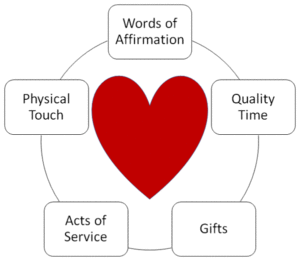As a marriage counselor, Gary Chapman has worked with scores of couples for whom the joy of partnership had faded and faced the looming prospect of separation. These folks did not lack concern for one another, but simply felt as though their emotional love tanks were perpetually dry. Through these encounters, Chapman discovered a fundamental truth: people speak different love languages. If we want our relationships to last, we need to identify – and learn to speak – the language that most resonates with our partners.
 Chapman characterizes these emotional dialects in The 5 Love Languages: The Secret to Love That Lasts. Mastery of a given dialect presumes the sincere intention of building others up and demonstrating commitment to their well-being. It is not to be used to manipulate behavior for personal gain.
Chapman characterizes these emotional dialects in The 5 Love Languages: The Secret to Love That Lasts. Mastery of a given dialect presumes the sincere intention of building others up and demonstrating commitment to their well-being. It is not to be used to manipulate behavior for personal gain.
Love Language #1 – Words of Affirmation – expresses appreciation for other’s good qualities or behaviors and demonstrates belief in their potential. It provides encouragement to pursue initiatives that we know to be deeply meaning to our partners without pressure to take action. It’s our vote of confidence. When making requests of our partners, we express our needs in a way that affirms our partners’ worth, abilities, and free exercise of choice. We give them the opportunity to do something meaningful for us, and acknowledge their contribution once completed. We also make a point of sharing our heartfelt appreciation for our partners with others. It fosters an aura of positivity that lifts up our partners in the retelling.
Love Language #2 – Quality Time – calls for giving our undivided attention to doing things with our partners that they enjoy. If the time spent focuses on quality conversation, we engage in sympathetic dialog where both parties share experiences, thoughts, feelings, and desires in a friendly and open manner. We commit to really listening. If it’s a shared activity, we dive in wholeheartedly knowing that we’re creating a memory bank of shared experiences on which we can both draw in the future.
Love Language #3 – Gifts – provides a tangible expression that our partners know what lights us up and invested the time and energy to get it. It says: “I was thinking about you.” Unless this token of appreciation is wildly mismatched with the giver’s means, it usually isn’t about the amount spent. It’s the thought, intention, and effort that went behind it.
Love Language #4 – Acts of Service – entails doing things your partner would like you to do. These acts must be things that genuinely matter to one’s partner and given freely as an expression of love. They typically require some thought, planning, time, effort, and energy. They may entail examining – and abandoning – stereotypes about the roles that men and women have assumed historically in partnership.
Love Language #5 – Physical Touch – entails holding hands, kissing, embracing, caressing, and sexual intercourse. It may show up as highly charged moments of encounter or casual gestures that manifest in small ways throughout the day. For those for whom this is their love language, to touch their bodies is to touch their hearts. It’s a powerful communicator of love.
If we ignore our partner’s love language, it’s akin to ignoring the needs of a garden. If we don’t weed, water, and fertilize, the garden will die a slow death. Even if our partner’s love language does not come naturally to us, make the choice to learn it anyway. It’s an even more profound expression of love.
How do we identify our love language? The author suggests contemplating answers to the following questions:
- In what way do your regularly express your love to your spouse? (You may be doing for them what you hope they’ll do for you.)
- What does your spouse do or fail to do that hurts you most deeply? (You may equate that action – or inaction – as a love barometer.)
- What have you most often requested of your spouse? (You may be giving your spouse hints about what makes you feel loved.)
Finally, don’t expect your partner to have E.S.P. (If you find it challenging to identify your love language, imagine how challenging it would be for your partner!) Do the work to figure out what fills your emotional tank, and then have a forwarding dialog with your partner about it.
As the Beatles famously sang, “All we need is love.”